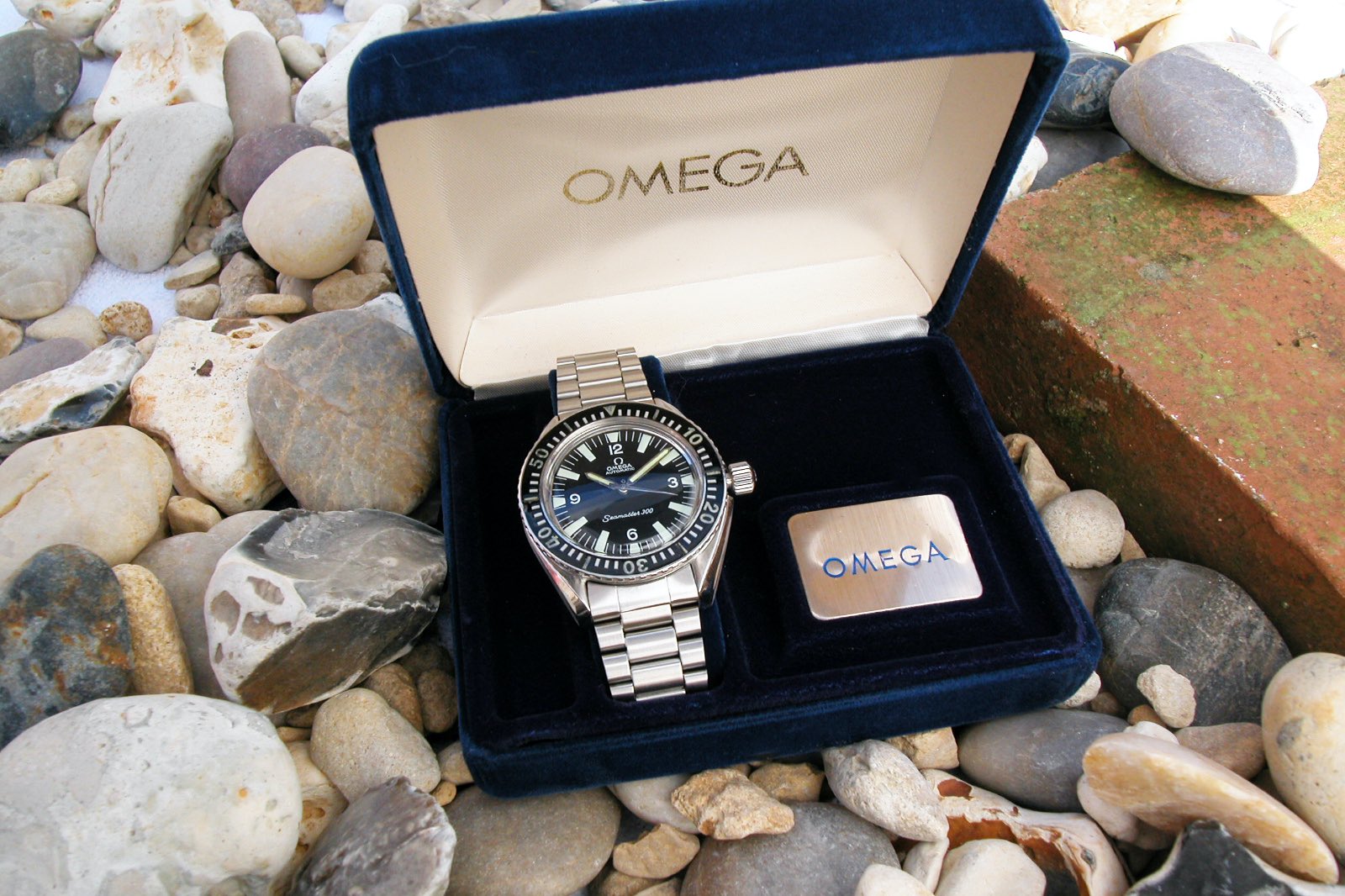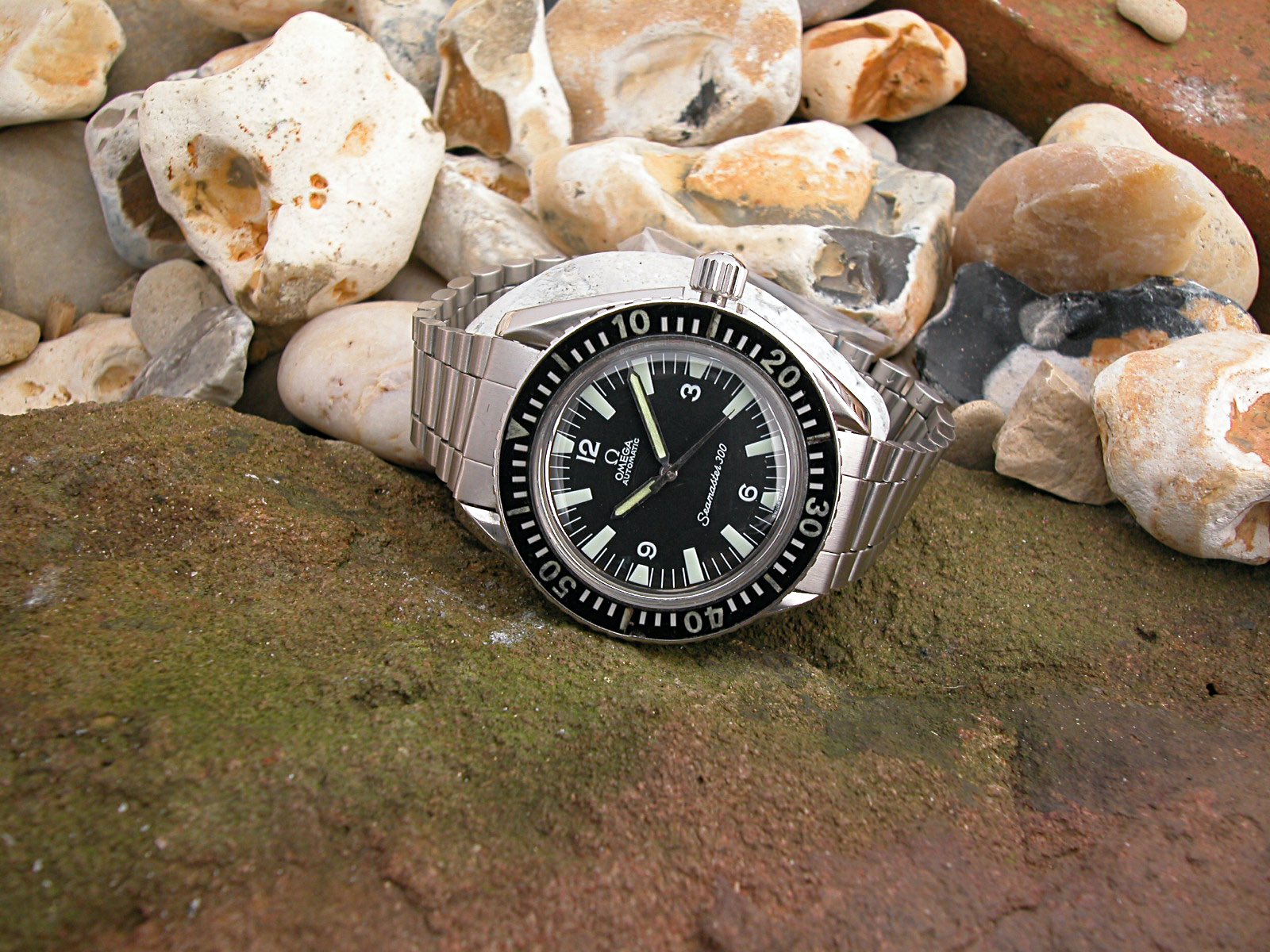When is a Seamaster 300 not a Seamaster 300? A Case Study on ‘Original Condition’ for Vintage Watches
Is "full originality" the right road to travel with vintage watches?

When it was originally launched back in the early 1960s, the Omega Seamaster 300 was, together with the Rolex Submariner, a mass-produced specialist dive watch for the burgeoning recreational diver market. There was also Blancpain and a few others like Doxa, Eterna, Favre Leuba, but none of them was on the same production scale. Today’s ‘Vintage Corner’ is not meant to be a history of the dive watch but more of an introduction to what you should look for in terms of the condition of these watches today. The idea is to understand what the term ‘in original condition’ means regarding these types of vintage tool watches. Particularly dive watches, like the Seamaster 300, which tend to have endured quite some action over their lifetimes.
The first generation Seamaster 300, with straight lugs, thin black bezel insert and ‘broad arrow’ hands, was replaced in 1963/1964 by the now well-known Seamaster 300 ST 165.024. It featured a case very similar to the Omega Speedmaster of the era. Similar proportions, with lyre lugs and even the same strap shoulder size. It was originally produced with ‘stick/pencil’ hands, large painted markers on the dial and a flat signed crown like the Speedmaster. A second model with date function was introduced just after 1964, designated ST 166.024.
The watch was produced with two types of automatic movements, using the Omega Calibre 552 no-date or the Omega Calibre 565 with date, from 1964 onwards. Calibres 563 and 560 may also be found in models sold to the US market; due to import restrictions, movements had a smaller jewel count – 17 jewels in this case, instead of 24 jewels.
These watches are like cars and made to be used for what they were built to do (professional or recreational diving). This means they had to be serviced and that some of their worn parts have been replaced. Entirely original watches may be few, which is understandable with tool watches like this – especially early dive watches from the 1960s. Original condition and box-and-papers insistence by some collectors has led to frauds with old worn parts being ‘whacked’ onto younger watches, in that pretence of originality. Just like vintage cars, buy a car with old bald tyres and shot brakes and the salesman will assure you that ‘it’s all original, Sir. But I wouldn’t drive it if I were you’. Apparently, it’s not uncommon to have a USD 5,000 difference in price between a perfect one (in its original box) and one that shows signs of a tough life.

- What we have here is an original 1960s Seamaster 300, whose dial was destroyed by water egress. Here, I restored the case to a buffed finish with brushed sides, as the original. The crown was replaced with a later tube and screw-in crown. The dial was swapped out for a new-old-stock one and all of these parts came from Omega (my watchmaker is accredited with all of the major groups). We matched the lume of the dial with what was found on the original hands, while retaining the original bezel, which has cracked at 5 o’clock. Early Perspex was used for the insert, which would expand and retract with heat and eventually break. Adding a ‘lighter’ NOS bracelet ref. 1171 completed this restoration.
- This one was almost entirely destroyed and I saved it… everything was NOS except the case and movement. This was a later example, with the sword hour hand. When it came to me, the hand-set was ruined, as was the dial. NOS sword hands were the correct replacement, the bezel was missing and the crystal was cracked. Both were replaced, together with the crown. NB. The bezel on this one came from Omega and looks slightly different but that was partially due to the wide lens used for the photo and the fact that it is a later version.
- Finally, on the far right, there is a pretty early model with a gilt dial. The other two needed to have their dials replaced. However, the dial on this early version was not in such a terrible condition, compared to the others. Thus, I just serviced the movement, cleaned and buffed the case. NB. These watches were for sale when they were not as rare or as valuable as they are now.
What is ‘Original Condition’?
Back in the 1960s and during the production period of the Seamaster 300, big manufacturers made thousands of watches a year. When evolutions on the case came along, or when model reference numbers changed, these were simply integrated into production. When new hands were decided, or even with advancements in technology (something quite common in the 1960s), these brands didn’t throw out the old parts they had in stock. New parts were simply integrated into the production run and parts phased in as older parts ran out. You can see this clearly with casebacks on the Rolex Submariner 5513. Many are known to have the earlier reference 5512 stamped inside, which is simply explained by the fact that there was a surplus to be used, before changing to 5513 models.
Here are a couple of Omega Calibre 552 movements to show the difference in their condition. Above, the matte and tarnished rotor is a sign of water getting into the movement and oxidizing the polished finish. Below is another 1960s Seamaster 300 with calibre 552, which looked almost brand new when it was opened. NB. you will see this effect on multiple original early Seamaster 300 watches, as the crown allowed water to come in. It was later changed to a screw-in crown and may not be seen as a sign of a swapped movement.
If you are looking for total originality, then you should keep certain things in mind. Just like with Rolex, if the watch was brought to Omega for service, either directly or through a service centre, they might have upgraded some of the worn-out cosmetic parts. This may not be standard practice, but I’m pretty sure they would suggest it as they would want the watch returned in the best possible condition – visually and mechanically. In this instance, the direction of total ‘originality’ may not be the best road to travel, in my opinion.
My thoughts on vintage watches, particularly early ‘tool watches’, are that upgraded crowns or replaced dials are part of the beauty of owning something that was originally designed to be used and abused, as an instrument. Thus, parts will have to be serviced or replaced. Certainly, a Seamaster 300 with a gilt dial would look better with original gold pencil hands rather than ‘later execution’ silver sword hands, fitted during service. However, this could be misleading for slightly less informed collectors. If a such a tool watch endured a tough life and had to go through several service cycles, with its original tritium dial swapped for a new-old-stock service dial, then I still think it is just as original as one that was left in a drawer for 30 years, after been flooded down at the coast one Spring morning in 1970. Something to consider, especially if you intend to wear your vintage watches intensively.








5 responses
Excellent information, and this time the book is only mentioned in the footer ! My compliments !
I have a 30 year old Heuer, over it’s life whenever I got it serviced TAG Heuer parts were used. What are your views on this tool watch that was used and serviced but obviously non-original? Kind of irrelevant now as Heuer can no longer supply parts so sadly it sits in a draw….
Yo hace unos años compre un reducido bastante malo y en omega me lo dejaron muy bien pero no original le pusieron un segundero nuevo (el grande ) y una nueva máquina ya que dijeron que estaba para ser reemplazada cristal nuevo y lo principal por que lo lleve ahí eslabones ya que la pulsera era chica y solo omega los tiene sino fuera por eso lo hubieras llevado a mi relojero y quedaba más original pero para tener algo para usar hay que hacer conseciones
Hi Ben, sure well as I say I think that if the parts come from TAG then that is the company so all fine…. A
I’m more a car guy than a watch guy..with cars, especially ones that were driven like an early Shelby GT350 Mustang, if the unibody, engine block and transmission case we’re original, the rest could be considered “service items”.
Now there are two types of “original” cars: those that are barn finds: totally original no new parts, even NOS is frowned upon. And restored to better than new using NOS parts, recreating paint daubs and chalk marks. They both ask for crazy prices, but the true, complete barn find is the holy grail.
Neither of these are considered drivers. They are trailer queens of the first order.
Me, I think things are honored by being used for their designed function. I have a 65 Mustang convertible that’s driven and has been modified to make it better… Like four wheel disc brakes.
I’m currently wearing a mid 80s Pulsar quarts just like I had in the mid eighties….
There is a place for perfect as produced product. Historians and museums. The rest of us should just buy and wear, and maintain with respect, fixing what’s broken as best we can.